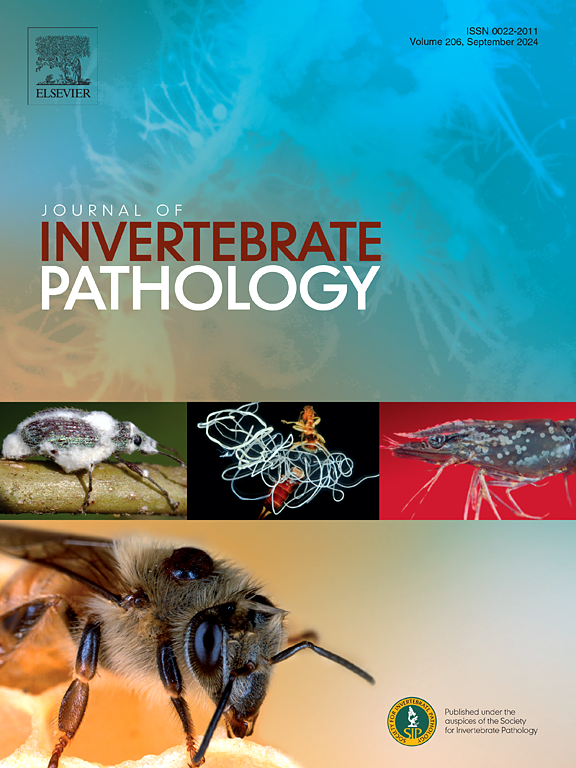急性肝胰腺坏死病(AHPND)感染的凡纳滨对虾中分离出一株pir抗体阳性的坎贝尔弧菌,对狮爪扇贝(Nodipecten subnodosus)幼鱼的敏感性
IF 2.4
3区 生物学
Q1 ZOOLOGY
引用次数: 0
摘要
急性肝胰腺坏死病(AHPND)是一种影响对虾的严重细菌感染,主要由携带pirAB毒素基因的弧菌引起。虽然AHPND已在虾类中进行了广泛的研究,但其对其他海洋无脊椎动物的潜在影响仍未得到广泛研究。本研究首次评价了幼狮爪扇贝(Nodipecten subnodosus)对从凡纳滨对虾暴发中分离的ahpnd相关的坎贝尔弧菌(VCAHPND-VP3)的易感性。浸泡实验感染显示出剂量依赖性反应,5 × 106 CFU/mL时累积死亡率为100 %,而较低浓度则导致亚临床感染。通过巢式PCR检测pirAB基因,证实了VCAHPND-VP3在鳃和胃组织中的存在。VCAHPND-VP3与原生溶藻弧菌菌株的比较致病性分析显示,尽管细菌摄取率相似,但只有VCAHPND-VP3导致高死亡率,突出了PirAB毒素在毒力中的关键作用。VCAHPND-VP3菌株的全基因组测序证实了pirab携带质粒的存在,先前报道为pVA1,并发现了与致病性和移动遗传元件相关的其他基因。这些结果证实了软体动物物种对ahpnd相关弧菌的易感性,并强调了沿海环境中pirab阳性弧菌传播的潜在生态风险。本文章由计算机程序翻译,如有差异,请以英文原文为准。

Susceptibility of Lion’s paw scallop (Nodipecten subnodosus) juveniles to a pirAB-positive Vibrio campbellii strain isolated from Litopenaeus vannamei shrimp affected by Acute Hepatopancreatic Necrosis Disease (AHPND)
Acute hepatopancreatic necrosis disease (AHPND) is a serious bacterial infection affecting penaeid shrimp, caused primarily by Vibrio species harboring the pirAB toxin genes. While AHPND has been studied extensively in shrimp, its potential impact on other marine invertebrates remains largely unexplored. This study evaluates, for the first time, the susceptibility of juvenile lion’s paw scallops (Nodipecten subnodosus) to AHPND-associated Vibrio campbellii (VCAHPND-VP3) strains isolated from Litopenaeus vannamei shrimp outbreaks. Experimental infection by immersion assays demonstrated a dose-dependent response, with 100 % cumulative mortality at 5 × 106 CFU/mL, while lower concentrations resulted in subclinical infections. The presence of VCAHPND-VP3 in gill and stomach tissues was confirmed by nested PCR detection of pirAB genes. Comparative pathogenicity assays between VCAHPND-VP3 and the native Vibrio alginolyticus strain revealed that, despite similar rates of bacterial uptake, only VCAHPND-VP3 caused high mortality, highlighting the critical role of PirAB toxins in virulence. Whole genome sequencing of the VCAHPND-VP3 strain confirmed the presence of the pirAB-carrying plasmid, previously reported as pVA1 and revealed additional genes associated with pathogenicity and mobile genetic elements. These results confirm the susceptibility of mollusk species to AHPND-associated Vibrio and highlight potential ecological risks related to the dissemination of pirAB-positive vibrios in coastal environments.
求助全文
通过发布文献求助,成功后即可免费获取论文全文。
去求助
来源期刊
CiteScore
6.10
自引率
5.90%
发文量
94
审稿时长
1 months
期刊介绍:
The Journal of Invertebrate Pathology presents original research articles and notes on the induction and pathogenesis of diseases of invertebrates, including the suppression of diseases in beneficial species, and the use of diseases in controlling undesirable species. In addition, the journal publishes the results of physiological, morphological, genetic, immunological and ecological studies as related to the etiologic agents of diseases of invertebrates.
The Journal of Invertebrate Pathology is the adopted journal of the Society for Invertebrate Pathology, and is available to SIP members at a special reduced price.

 求助内容:
求助内容: 应助结果提醒方式:
应助结果提醒方式:


